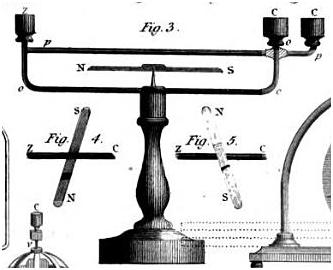
This is an engraving from Sturgeon’s paper, “Account of an improved Electro-magnetic Apparatus,” published in Annals of Philosophy, Vol. 12. The accompanying description reads:
“Fig. 3. A stand supporting a needle between two conducting wires oo and pp to show the different effect of electricity on the needle when passing above or below it; the cup z is common to both, but the other ends have each a separate cup cc: when the electric current passes along the upper wire, pp the needle takes the position as shown in fig. 4; but on lifting the connecting wire out of the cup pc, and putting it into the cup oc, the current passes through the under wire oo, and the needle immediately goes round to the position indicated in fig. 5; then if you watch the motion of the needle, and keep alternately transferring the wire out of one cup into the other, keeping time with the needle, you may bring it into the most rapid revolution that you can possibly keep time with.”
It was an apparatus commonly owned by scientists of the time to demonstrate Oersted’s discovery of the deflection of the needle. The mercury cups provided connections that could be changed between cups oc and pc, so that current would pass between either the top or bottom wire. The magnetic needle inside would deflect in opposite directions depending on whether current passed above or below it.

Professor Henry owned one such apparatus, and used it to demonstrate Oersted’s discovery for his classes. This is a sketch of the apparatus found in Henry C. Cameron’s student notebook (1846-7). Henry’s apparatus is now housed in a display case in Princeton’s Physics Department.
